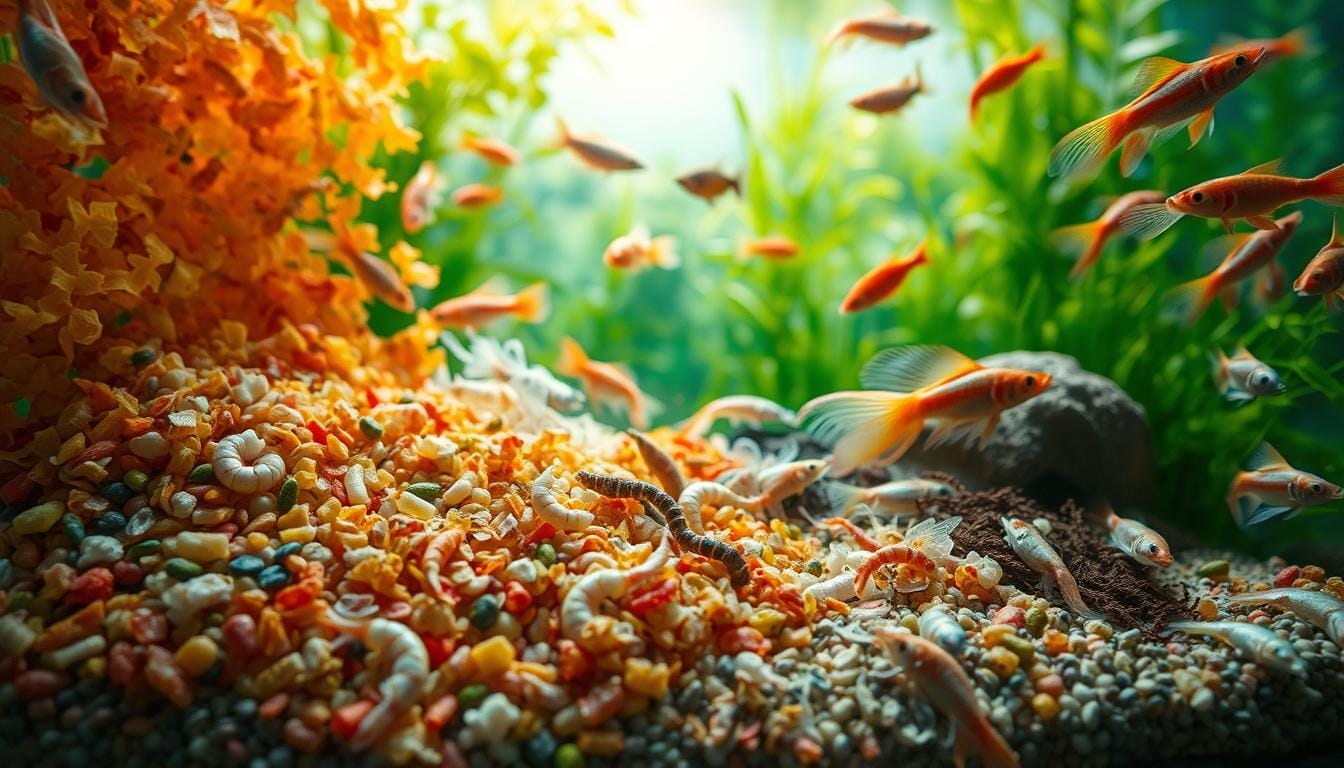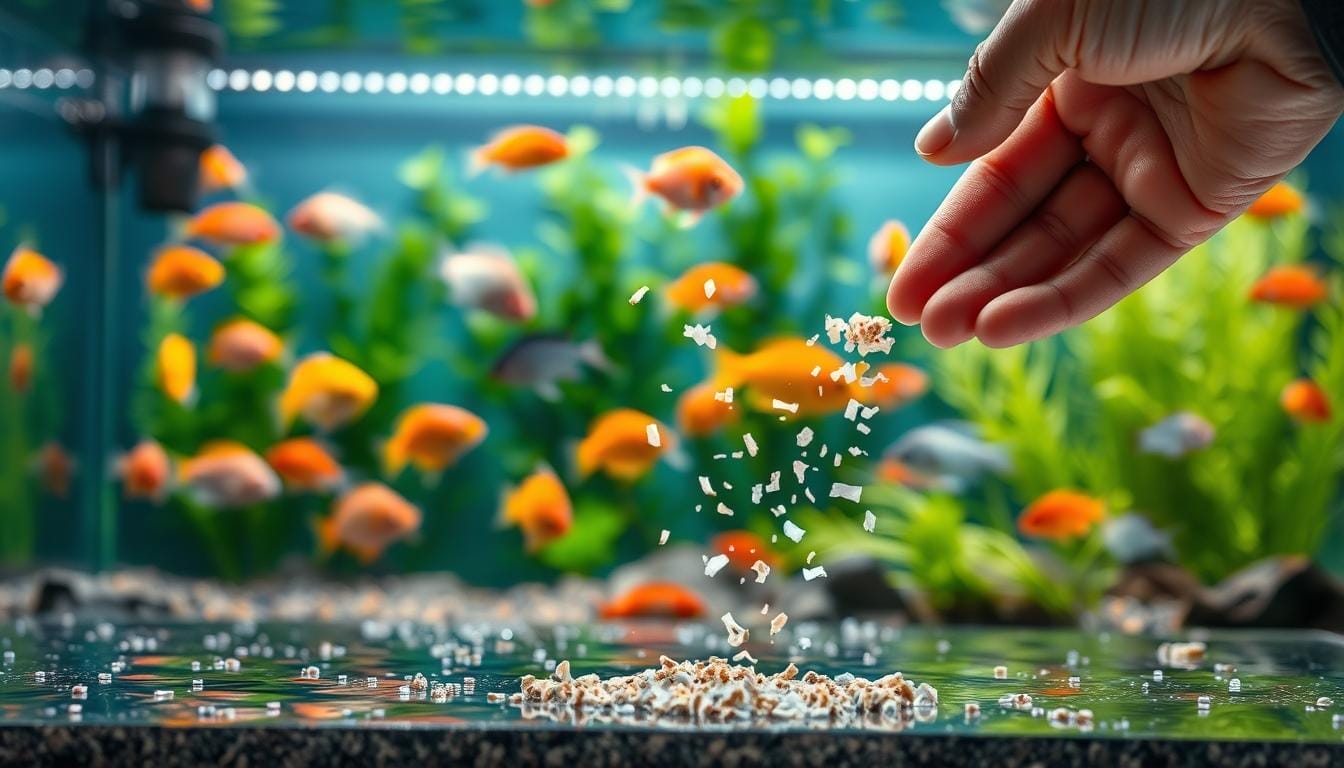
Nourish Your Aquarium Fish with High-Quality Frozen Fish Food

Did you know 53% of aquarium owners rely solely on dry flakes or pellets to feed their aquatic pets? While convenient, these options lack the nutrient diversity wild species naturally consume. Your fish deserve better than a repetitive “protein bar” diet.
Premium frozen options offer what processed meals can’t: living-world nutrition. Think juicy brine shrimp packed with omega-3s or vitamin-enriched bloodworms that mirror natural prey. These meals retain moisture and texture, triggering instinctual hunting behaviors in even the fussiest eaters.
Many hobbyists report visible changes within weeks of switching. Brighter colors, increased activity, and improved breeding success often follow. Sick or stressed fish particularly benefit from the easy digestion and appetizing aroma.
Ready to upgrade your feeding routine? We’ll show you how frozen diets support healthier ecosystems, reduce waste, and keep your underwater friends thriving. Let’s explore why experts call this the gold standard for aquatic care.
Understanding the Benefits of Frozen Fish Food
Aquatic pets thrive when their meals mirror what they’d find in nature. Unlike processed alternatives, flash-frozen options preserve essential nutrients through rapid freezing techniques. This method locks in vitamins and amino acids that support vibrant coloration and active behavior.
Nutritional Advantages for Aquatic Health
Premium frozen foods deliver three key benefits:
- Pathogen-free safety: Low-temperature processing eliminates parasites that cause common tank diseases
- Complete nutrition: Proteins and fatty acids remain intact, supporting muscle development and scale health
- Immune support: Natural antioxidants help combat stress-related illnesses
Enhanced Digestion and Vitality
Your tank residents digest these meals easier than dry alternatives. The moisture-rich texture:
- Reduces bloating and swim bladder issues
- Triggers natural feeding responses through authentic textures
- Provides energy for breeding behaviors and social interactions
Owners often notice brighter colors within 2-3 weeks. Species like bettas and cichlids particularly benefit from the diverse nutrient profiles found in quality frozen diets.
Exploring Different Types of Frozen Foods for Aquariums
Diversity in your tank’s menu isn’t just a luxury—it’s essential for mimicking natural ecosystems. Let’s dive into popular options that cater to different species and dietary needs.
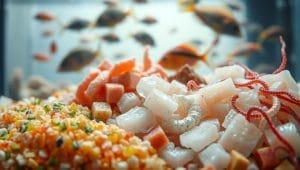
Frozen Bloodworms, Tubifex, and Brine Shrimp
Meat-eating species like bettas and pufferfish go wild for bloodworms. These protein-packed midge fly larvae contain hemoglobin, which supports energy levels and vibrant hues. Bottom feeders like corydoras thrive on tubifex worms, which sink quickly and encourage natural scavenging behaviors.
Brine shrimp serve a dual purpose: their soft bodies deliver amino acids, while their chitin-rich shells aid digestion. For an extra nutrient boost, try spirulina-enriched varieties. These crustaceans absorb algae before freezing, packing meals with color-enhancing vitamins.
Variety and Nutrient Profiles of Each Option
Match ingredients to your pets’ needs:
- Mysis shrimp: Ideal for larger species, offering calcium for bone health
- Krill: Rich in astaxanthin to intensify red and orange pigments
- Silversides: Whole prey items that stimulate hunting instincts
Rotating these ingredients prevents dietary gaps and keeps meals exciting. Observe your pets’ responses—active feeding and bright scales signal you’ve chosen well!
Choosing the Right Feed Based on Your Fish Species
Feeding your tank inhabitants isn’t one-size-fits-all; size and species matter. Tiny nano animals and filter feeders struggle with large chunks, so opt for miniature frozen options like daphnia or cyclops. These crustaceans measure under 0.2 inches—perfect for small mouths.
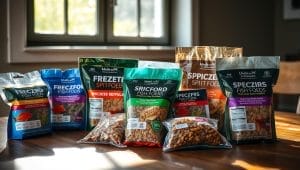
Newborn fry need even tinier meals. Frozen baby brine shrimp at 450 microns provide essential fats without overwhelming developing digestive systems. For larger aquatic pets, select feeds with bigger pieces that encourage natural hunting behaviors.
Consider texture too. Species like pufferfish require crunchy shells to manage continuously growing teeth. Match food hardness to your pets’ biological needs for optimal health.
- Size matching: Offer morsels smaller than your animal’s mouth width
- Life stage matters: Fry formulas differ from adult diets
- Feeding zones: Choose sinking or floating varieties based on where inhabitants eat
In mixed-species tanks, combine small and large particle foods. This approach ensures all residents receive nutrition suited to their feeding capabilities. Watch how your aquatic community responds—active eating and vibrant colors confirm you’ve nailed their menu!
How to Safely Thaw and Prepare Frozen Foods
Did you realize improper thawing could undo all the benefits of premium meals? How you handle these nutrient-packed cubes determines whether your aquatic pals get maximum nourishment or risky leftovers. Let’s master safe preparation together.
Proper Thawing Techniques
Quick-start method: Drop cubes directly into your tank. Cold-resistant species like goldfish enjoy chasing thawing morsels. For shy eaters, pre-thaw in a shot glass filled with tank water for 5 minutes. Use a pipette to target-feed bottom dwellers or compete-free zones.
Always match portion sizes to eating habits. Leftovers decay fast, so make sure your pets finish meals within 2 minutes. This prevents waste and keeps water parameters stable.
Maintaining Nutrition and Avoiding Spoilage
Never leave thawed meals at room temperature beyond 30 minutes. Harmful bacteria multiply rapidly, turning feasts into hazards. If you need extra time, store prepared portions in the fridge for up to 4 hours.
Refreezing? Big mistake. Ice crystals rupture cell walls during repeated thaws, leaking nutrients and inviting parasites. Stick to single-use portions—your pets deserve fresh goodness every meal.
- Set phone reminders for feeding time
- Use dedicated thawing containers to prevent cross-contamination
- Check expiration dates: Even frozen food doesn’t last forever
Make sure your routine eliminates risks while preserving every vitamin. Your tank’s vibrant colors and active swimmers will prove you’ve nailed it!
Proper Feeding Techniques and Portion Control
Balancing your aquarium’s meals requires more than just dropping a cube in the tank. Smart delivery methods ensure every inhabitant gets proper nutrition without waste. Whether you prefer hands-on care or automated solutions, understanding portion management transforms feeding from a chore into an art.
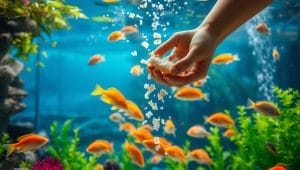
Manual Feeding Mastery
For those who enjoy interactive care, worm feeder cones create a controlled buffet. These devices slowly release meals, letting shy eaters grab their share before aggressive tankmates dominate. Observe your aquatic pets during meals—active competition means you might need multiple feeding zones.
Automated System Advantages
Devices like the aF4 feeder simplify routines with preset schedules. While convenient, they work best for stable communities without dietary variations. Pro tip: Combine automation with weekly manual checks to monitor body conditions and adjust amounts.
Three signs you’re serving ideal portions:
- Slightly rounded bellies without bloating
- Less than 5% uneaten material after 2 minutes
- Consistent energy levels during active hours
For single bettas, start with quarter-cube servings. In community tanks, match morsel sizes to the smallest resident’s mouth. Remember: leftovers pollute water, while underfeeding stresses your ecosystem. Track changes weekly—your observations fine-tune the perfect menu!
Incorporating Frozen Fish Food into Your Aquarium Diet
Your aquarium’s menu needs careful planning to keep inhabitants thriving. Start by matching feeding frequency to species needs—community tanks often thrive with nutrient-rich meals 2-3 times weekly. Specialized feeders like pufferfish may require daily servings to maintain energy levels and natural behaviors.

Transitioning from dry flakes? Soak new meals in tank water for 30 seconds before mixing with familiar foods. Gradually increase frozen portions over 7-10 days. This method helps hesitant eaters adjust without stress.
For stubborn pets that refuse alternatives:
- Use feeding tongs to mimic live prey movement
- Pair frozen items with types of nutrient-rich options like gel foods
- Offer meals during active periods when appetites peak
Rotate between four food categories weekly: frozen, freeze-dried, prepared, and live. This variety prevents nutritional gaps while keeping meals exciting. Track responses through these signs:
• Improved coloration within 3 weeks
• Consistent foraging behavior
• Stable growth rates in young specimens
Adjust schedules based on these observations. A well-planned diet simplifies aquarium care while creating vibrant underwater ecosystems. Your pets’ vitality becomes the best indicator of success!
Addressing Concerns Over Preservatives and Pathogens
Smart aquarium keepers question what’s hidden in their pets’ meals. While frozen diets offer superior nutrition, preservatives and pathogens remain valid concerns. Let’s separate myths from facts to protect your aquatic ecosystem.
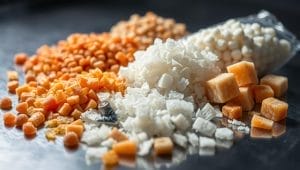
Recognizing Safe Versus Harmful Preservatives
Not all additives threaten tank health. Safe options like sodium chloride and citric acid stabilize meals without harming inhabitants. These naturally occurring substances prevent spoilage while maintaining nutritional value.
Avoid products listing sulfites or benzoates. These chemical preservatives can weaken immune systems and disrupt water chemistry. Always check labels—quality brands prioritize transparency about ingredients.
Preventing Pathogen Contamination in Frozen Foods
Flash-freezing at -40°F (-40°C) eliminates most parasites and bacteria during processing. This deep-freeze method disrupts cell structures in harmful organisms, making meals safer than live alternatives.
Store cubes in airtight containers to prevent freezer burn. Thaw only what your pets consume immediately—refreezing invites bacterial growth. When handling meals:
- Use dedicated utensils to avoid cross-contamination
- Discard discolored or foul-smelling cubes
- Never mix thawed and frozen portions
Your aquatic pals deserve meals that nourish without risks. By understanding preservation methods and storage best practices, you create a dining experience that supports vibrant health and disease prevention.
Elevating Your Aquarium Care with Expert Feeding Practices
Transforming your tank into a thriving ecosystem starts with mindful feeding habits. By addressing nutrient deficiencies through varied meals, you create a foundation for long-term health. Options like mysis shrimp deliver essential proteins that support muscle growth and immune function in aquatic life.
When you buy frozen options, pair them with fresh alternatives for balanced nutrition. Consider cultivating your own live cultures to supplement store-bought diets. This approach reduces reliance on processed items while keeping meals exciting.
Portion control remains critical—serve amounts your pets finish within two minutes. Observe their behavior: active foraging and consistent energy levels signal ideal feeding practices. Regular rotation between protein sources prevents dietary boredom and boosts coloration.
Your dedication to quality nutrition shines through in every vibrant scale and darting swim. With these strategies, you’ll maintain water clarity and foster a lively underwater community that reflects your expert care.
FAQ
Why should I choose frozen options over dry flakes or pellets?
Frozen meals retain more natural nutrients and proteins compared to processed alternatives, supporting better coloration, digestion, and immune function. They’re also less likely to cause bloating or water pollution when prepared correctly.
How do I safely thaw frozen meals for my aquarium?
Place the portion in a small container with tank water for 5–10 minutes. Avoid microwaving or hot water, which can destroy vitamins and increase bacterial growth. Rinse lightly before feeding to remove excess particles.
What types work best for carnivorous vs. herbivorous species?
Carnivores thrive on protein-rich choices like brine shrimp or bloodworms, while herbivores benefit from spirulina-blended cubes or vegetable-based mixes. Always research your specific species’ dietary needs first.
Can I feed frozen items daily?
While nutrient-dense, these should complement a varied diet. Offer them 2–3 times weekly alongside high-quality pellets or algae wafers to prevent nutrient imbalances. Adjust based on your tank’s waste levels.
Are there risks of parasites in frozen products?
Reputable brands like Hikari or San Francisco Bay use irradiation or flash-freezing to eliminate pathogens. Always purchase from trusted suppliers and avoid refreezing thawed portions to minimize contamination risks.
How do I avoid overfeeding with frozen cubes?
Break cubes into smaller pieces using a grater or knife. Feed only what your aquatic pets consume in 2–3 minutes. Remove uneaten bits promptly to maintain water quality.
Can frozen diets replace live foods entirely?
They’re a safer, more convenient alternative to live options, which may carry diseases. However, occasional live treats (like cultured Daphnia) can stimulate natural hunting behaviors in certain species.
Do frozen options provide enough vitamins long-term?
High-quality brands fortify their products with essential fatty acids and vitamins like C and E. Rotate between different types (e.g., mysis, krill, plankton) to ensure a balanced intake of micronutrients.





